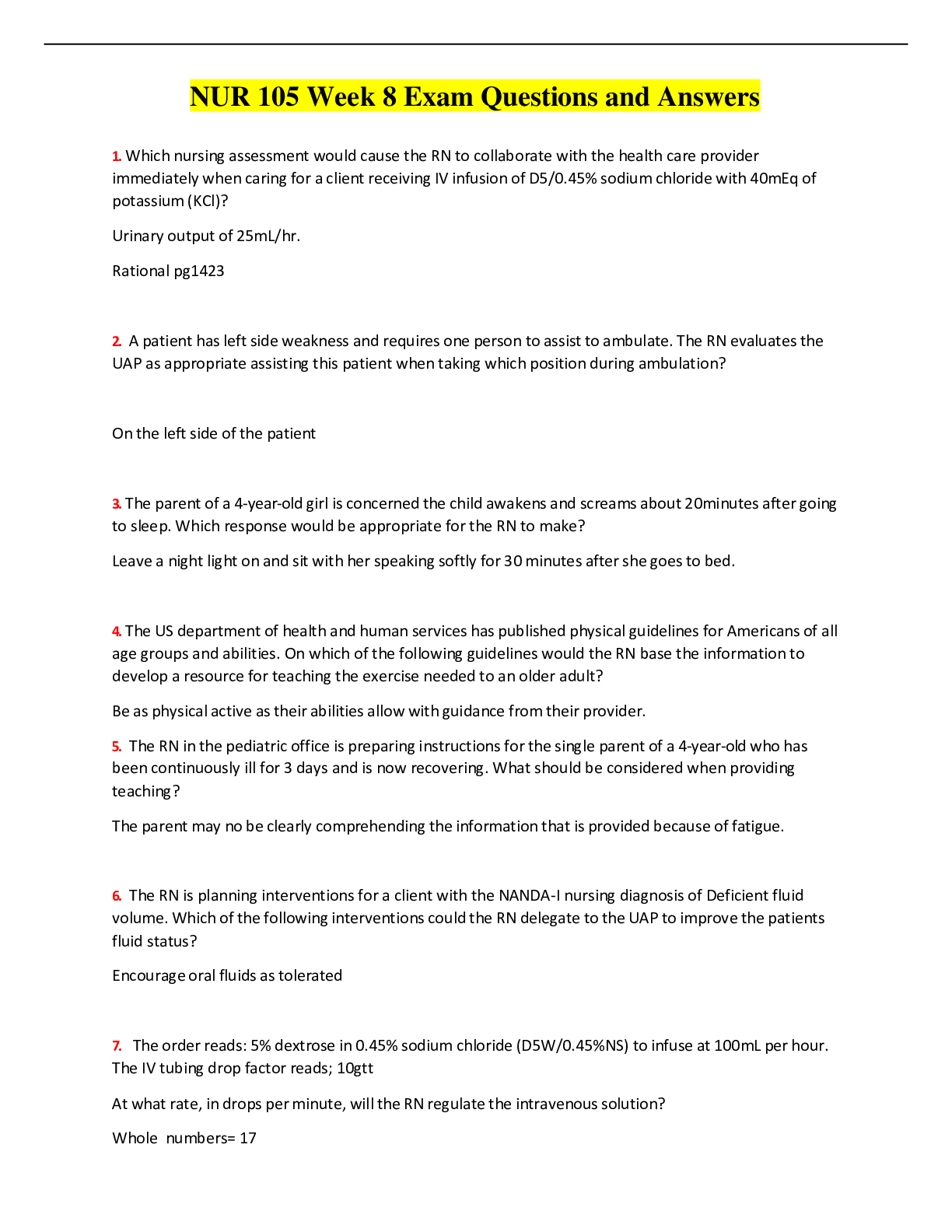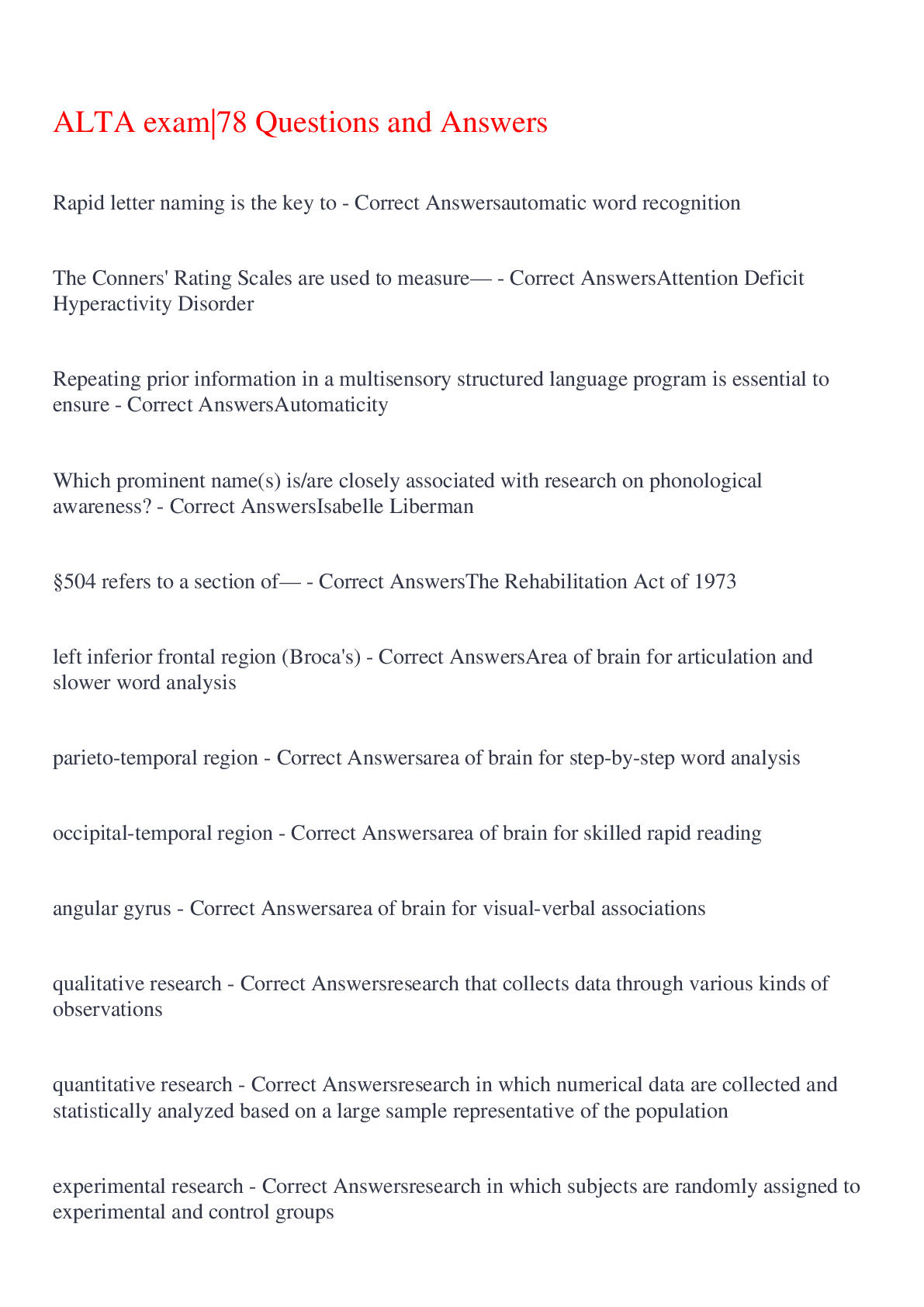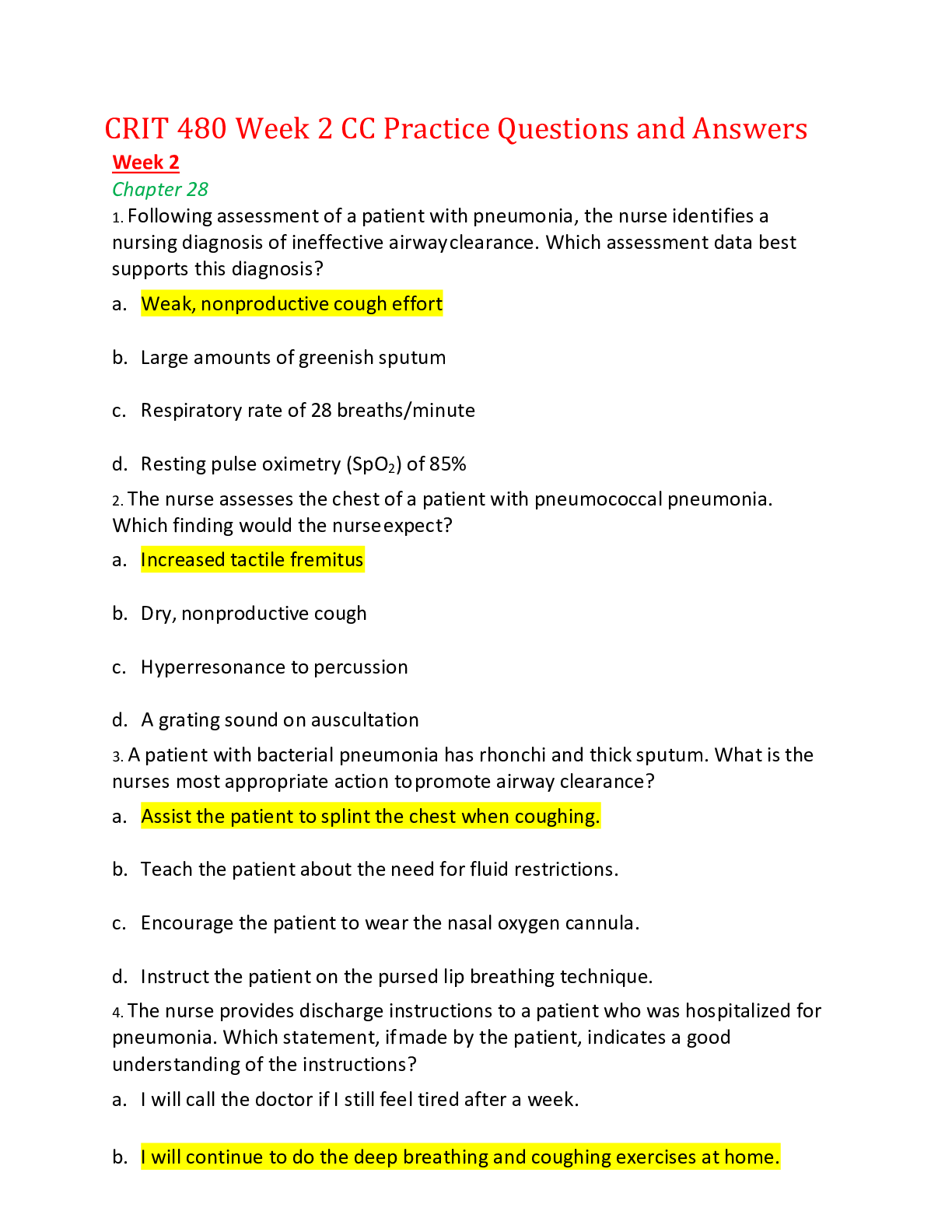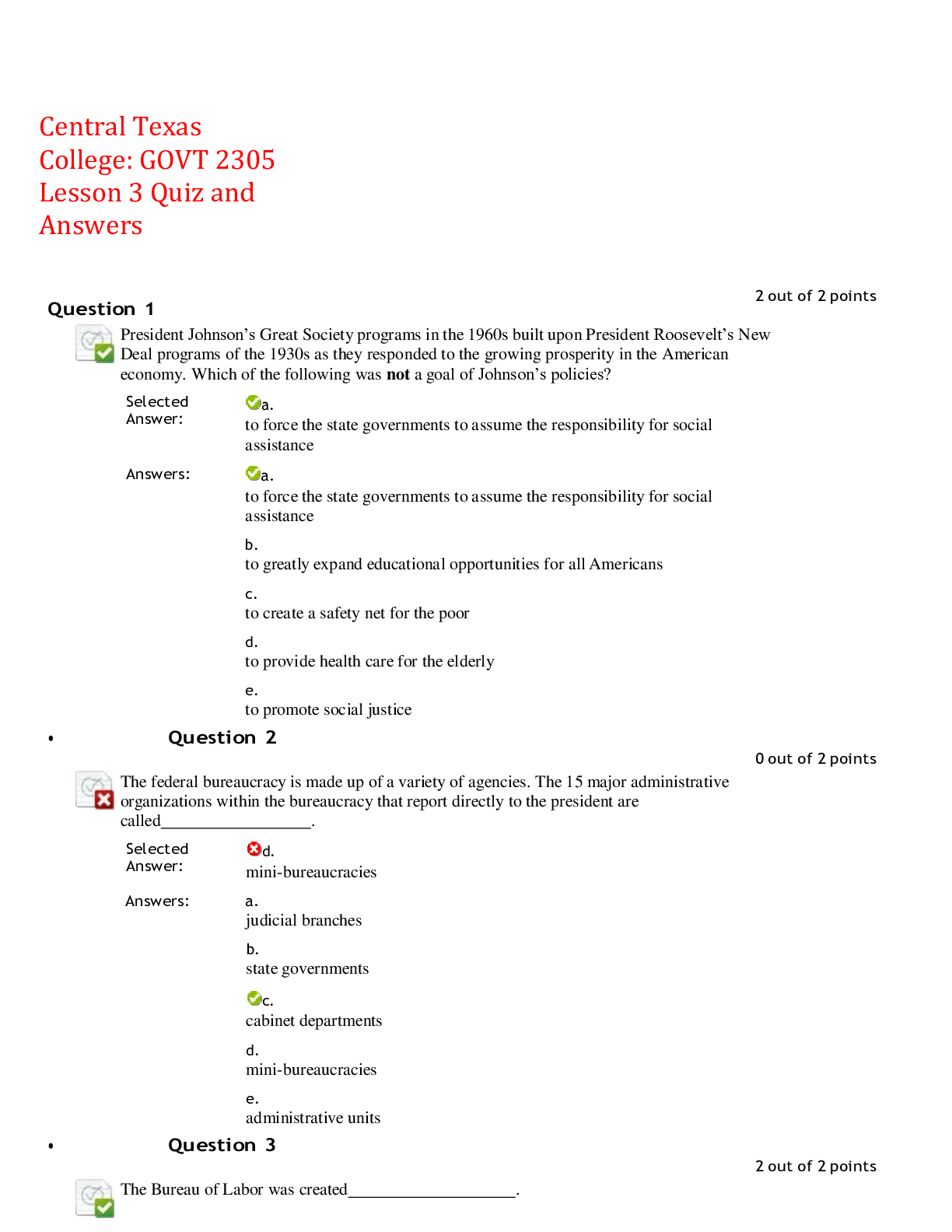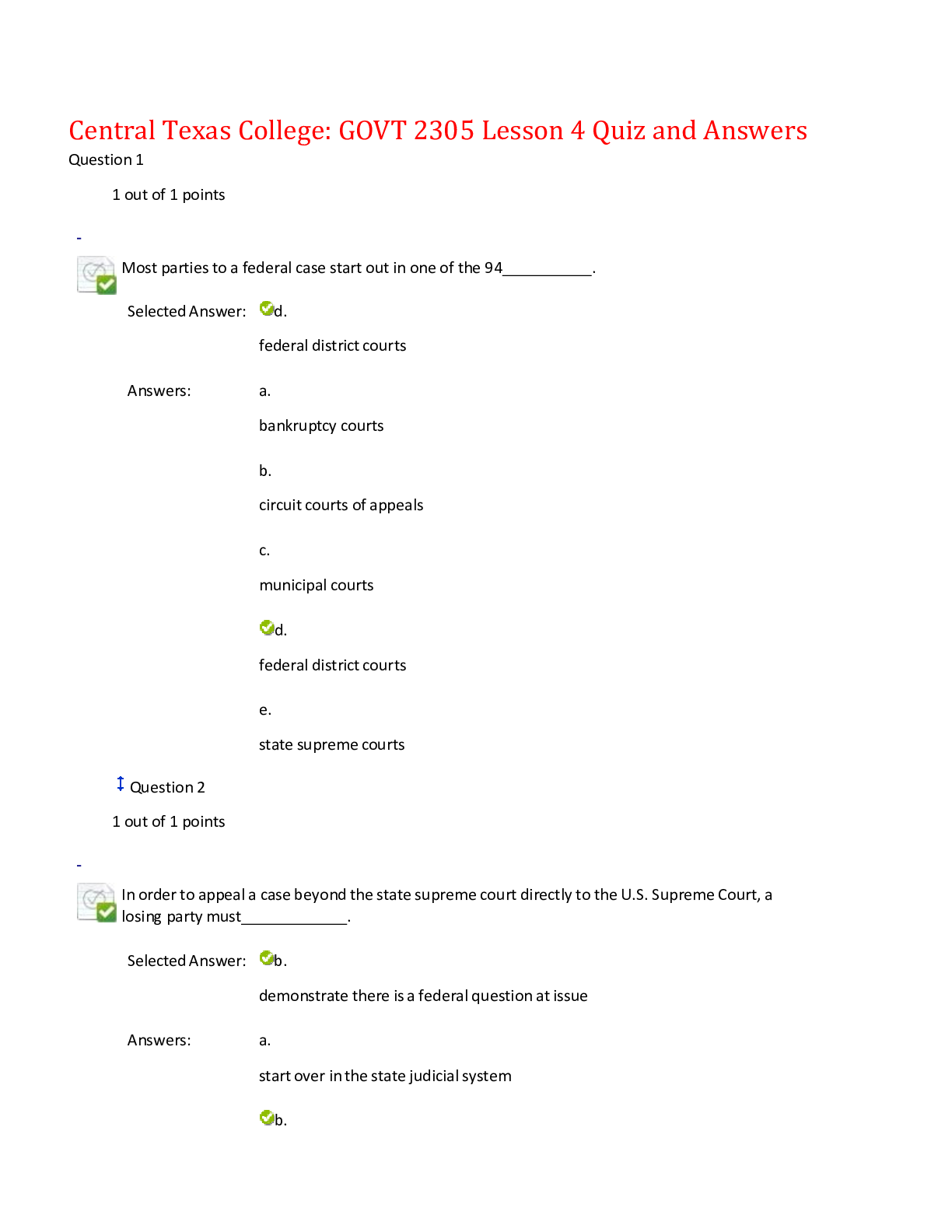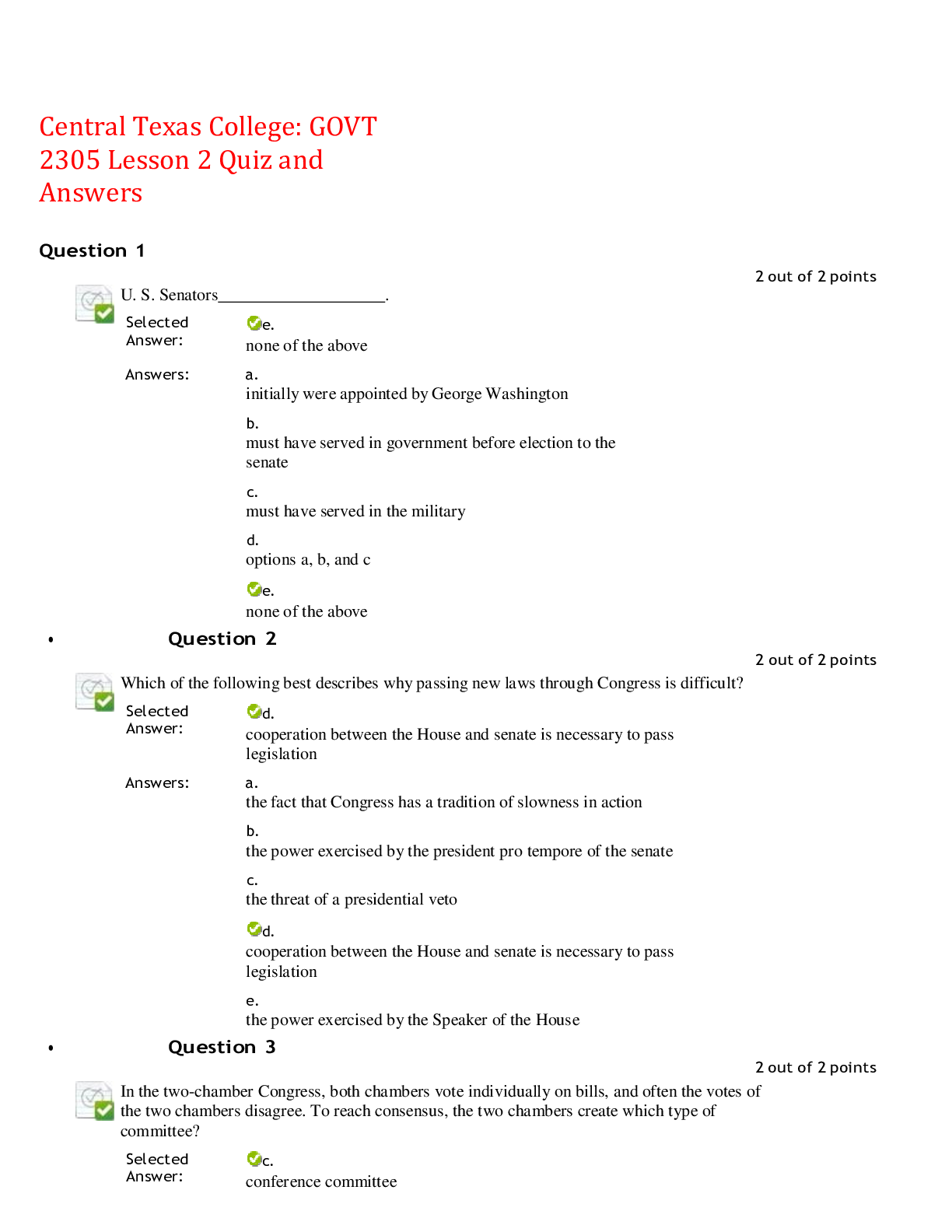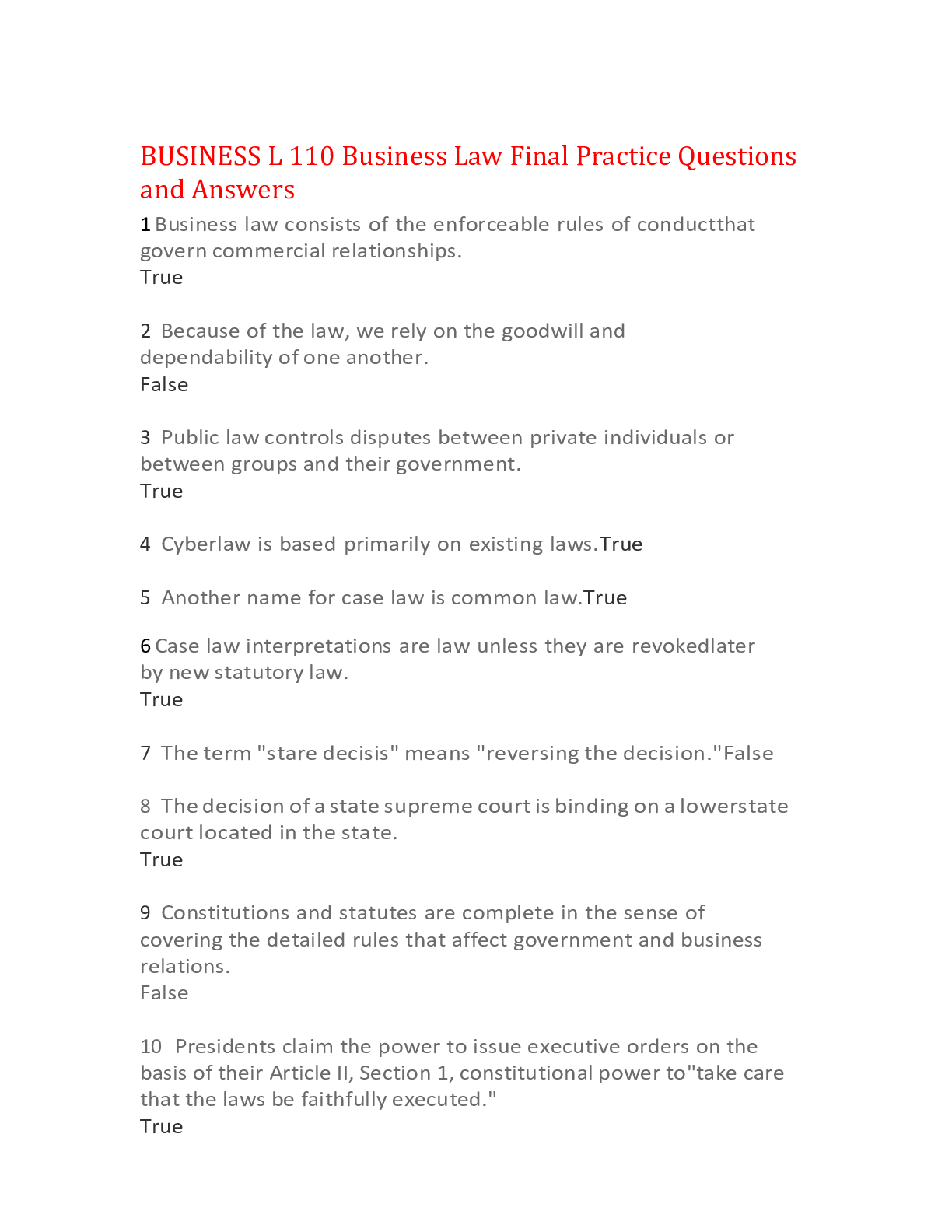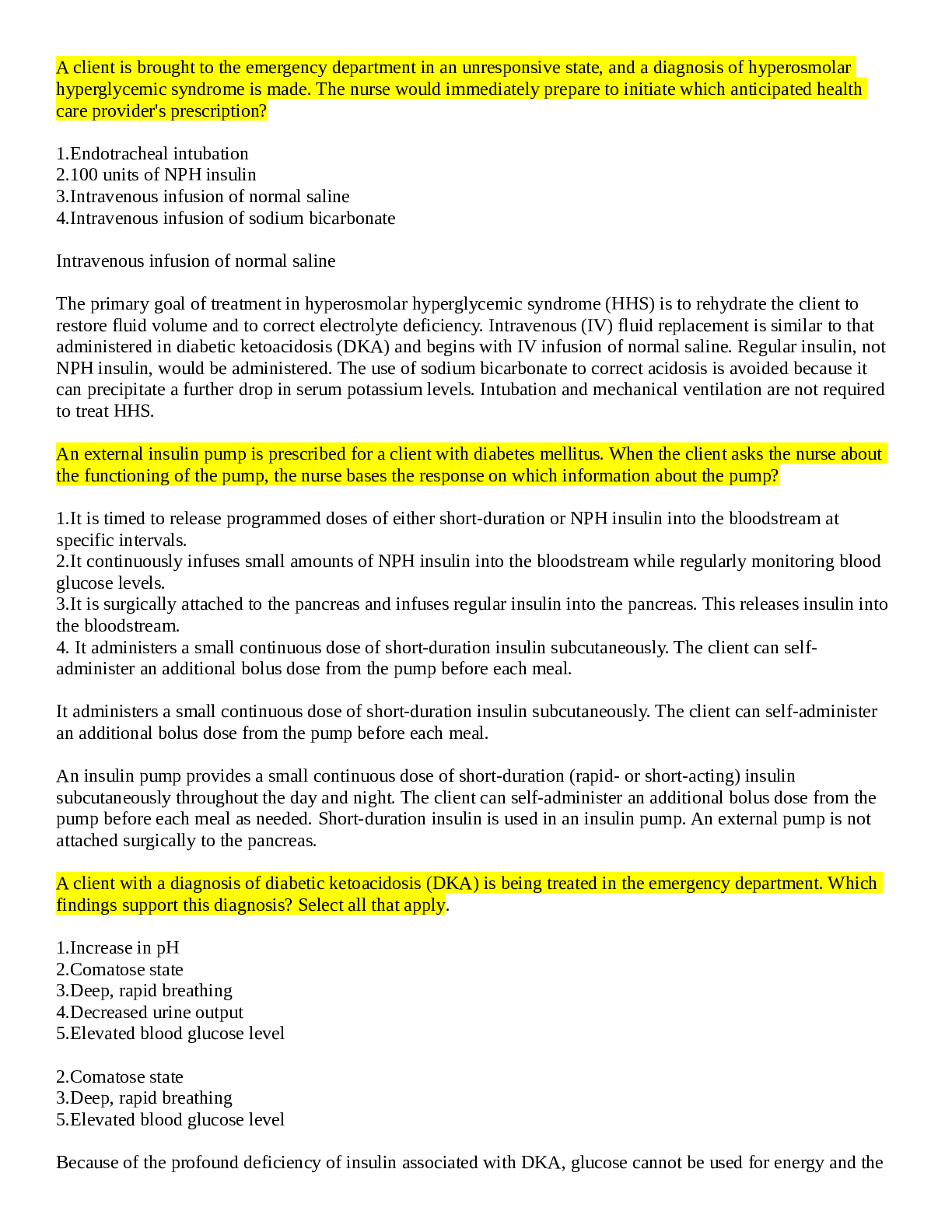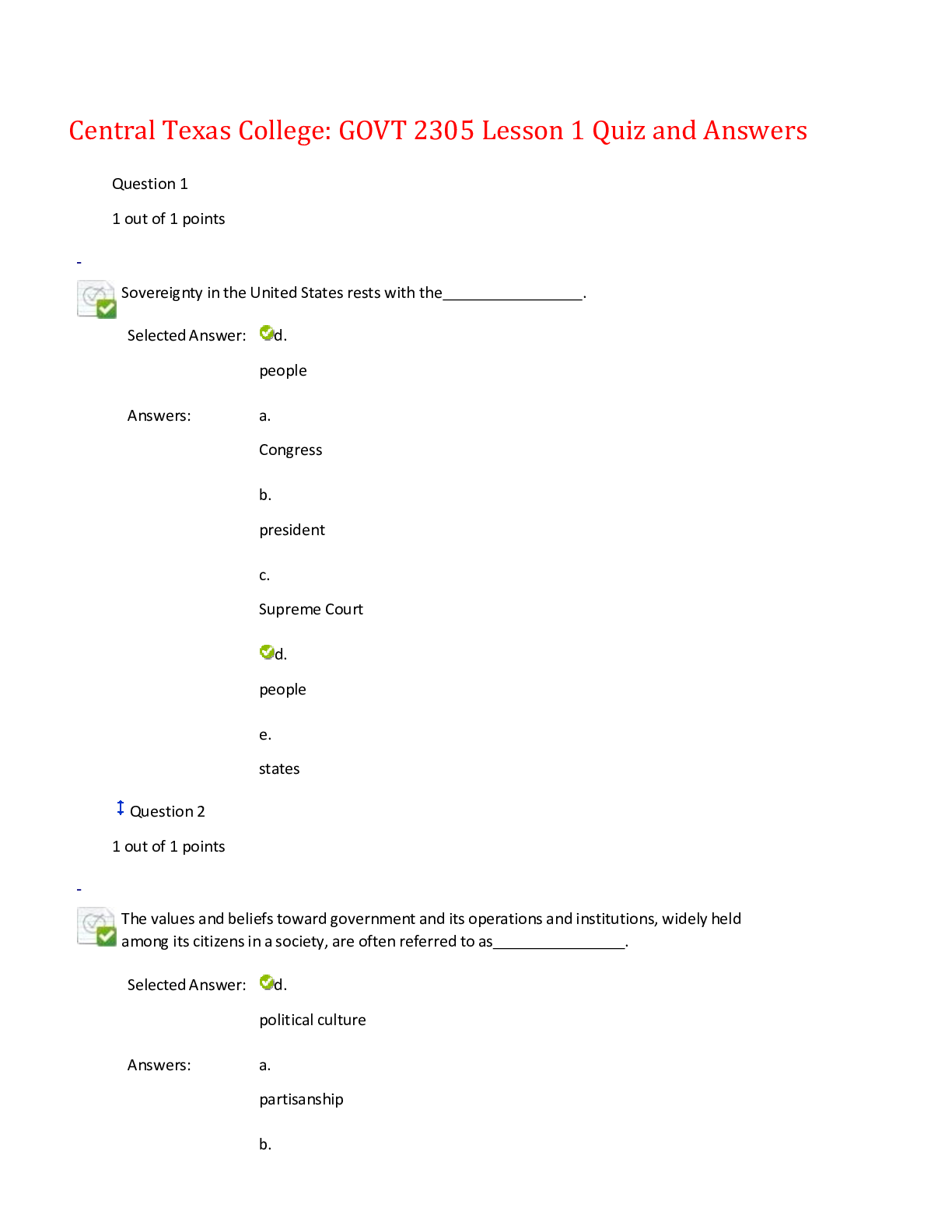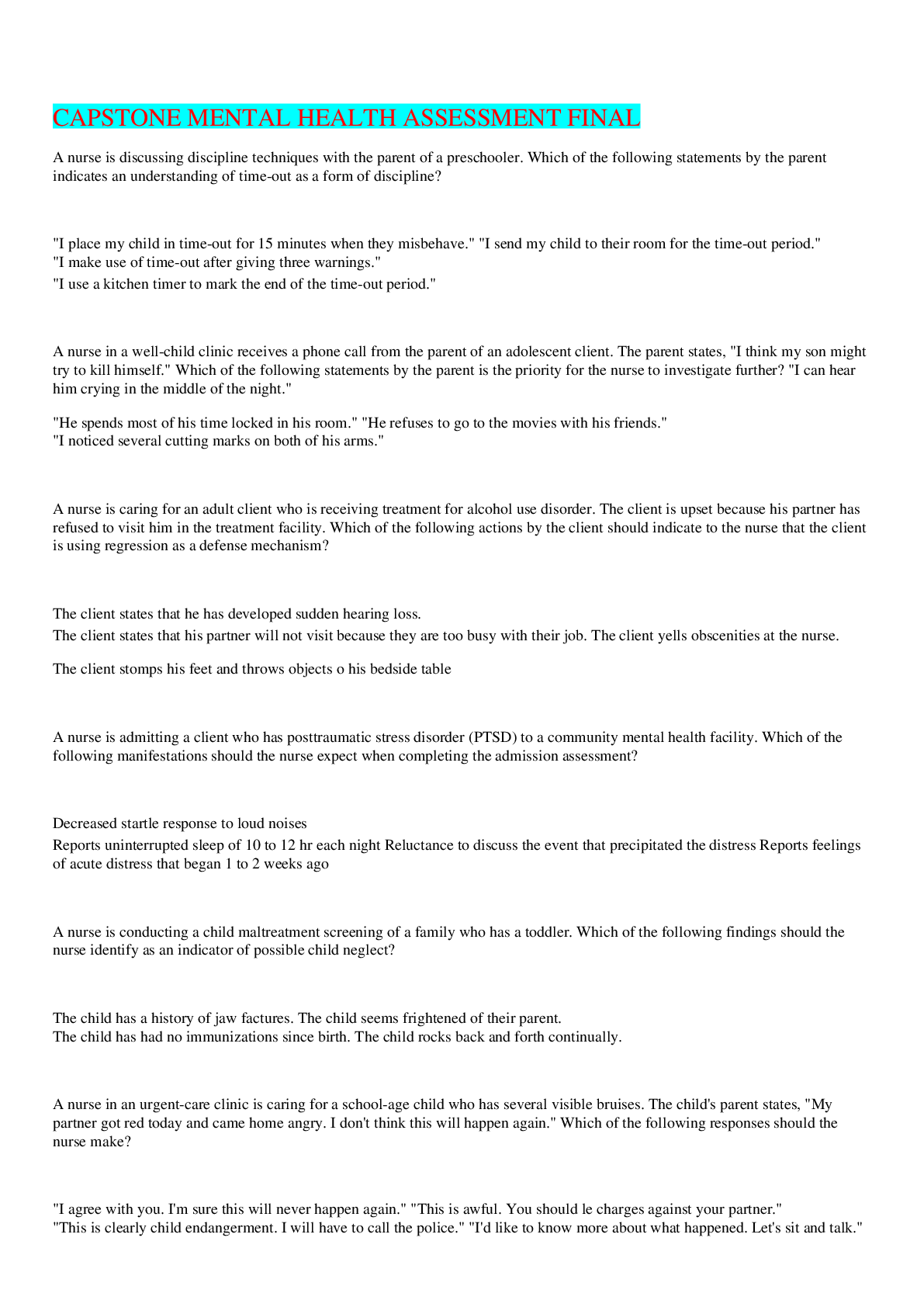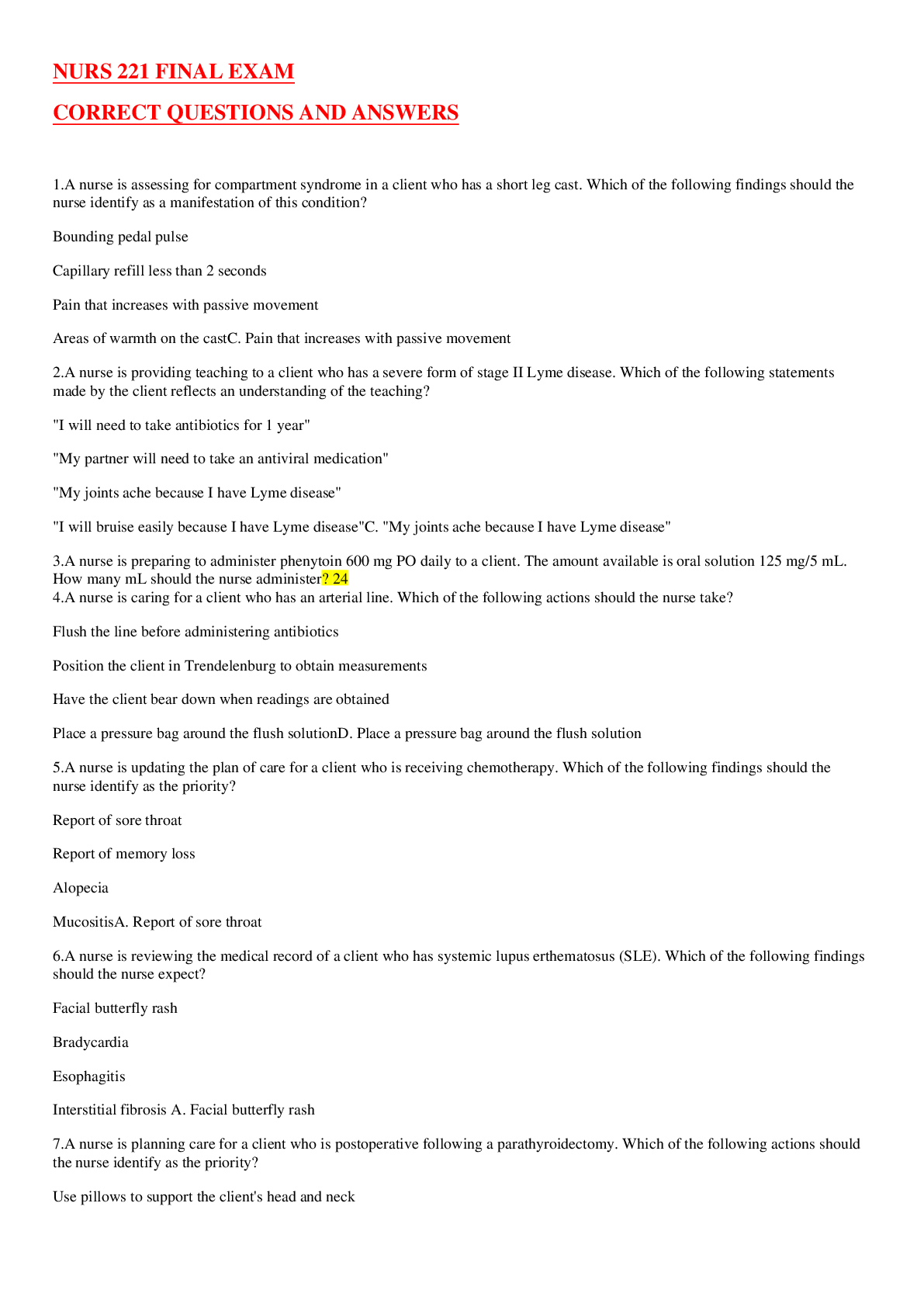*NURSING > EXAM > NURS 406 Assessment Nursing Care of Children Questions and Answers,100% CORRECT (All)
NURS 406 Assessment Nursing Care of Children Questions and Answers,100% CORRECT
Document Content and Description Below
NURS 406 Assessment Nursing Care of Children Questions and Answers 1. A home health nurse is providing teaching about post seizure management to the parents of a school age child who has epilepsy a... nd experiences tonic-clonic seizures.Which of the following instructions should the nurse include in the teaching? (Selectall that apply.) "Hyperextend your child's head for 5 minutes following a seizure." "Immediately following a seizure, give your child 6 ounces of water." "Following a seizure, record the length and characteristics of your child's seizure.""Administer rectal diazepam to your child following a seizure." "Call for emergency medical services if the size of your child's pupils are unequal after aseizure." 2. A nurse in a pediatric clinic is discussing the pathophysiology of Reye syndrome with a newly licensed nurse. Which of the following statements by the newly licensednurse indicate an understanding of the disorder? "Reye syndrome causes fatty changes in the liver." "Reye syndrome leads to venous thrombus formation." "Reye syndrome is associated with misuse of acetaminophen.""Reye syndrome is linked to decreased serum ammonia levels 3. A nurse is teaching the parents of a toddler about strategies to manage tempertantrums. Which of the following instructions should the nurse include in the teaching? "Honor the child's request if she holds her breath.""Establish a structured daily routine for the child." "Place the child in her room alone until the temper tantrum ends.""Comfort the child during the temper tantrum." 4. A nurse is completing an assessment following suctioning of a child who has a tracheostomy. Which of the following findings should the nurse identify as anindication that the procedure has been effective? Increased respiratory rate Decreased oxygen saturationClear breath sounds Increased oral secretions 5. A nurse is developing a plan of care for a 4-year-old child who has hemophilia and isexperiencing acute hemarthrosis. Which of the following interventions should the nurse include in the plan? Have the child perform passive range-of-motion exercises.Administer aspirin as needed for pain. Place ice packs on the affected joints. Position the lower extremities below the level of the heart. 6. A nurse in the emergency department is caring for a preschooler who hasepiglottitis. Which of the following actions should the nurse take? Place the child in a left lateral position. Obtain a specimen from the child's throat for a culture. Inspect the child's throat with a padded tongue depressor.Initiate droplet precautions for the child. 7. A nurse is providing teaching to the parent of a child about home care following a cardiac catheterization. Which of the following statements should the nurse include? "You should give your child aspirin if they report pain at the site." "You can remove the pressure dressing 8 hours after the procedure.""Your child can soak in the bathtub 24 hours after the procedure." "Your child should avoid strenuous physical activities for several days." 8. A nurse is admitting a child who has pertussis. Which of the following isolationprecautions should the nurse initiate? Droplet Contact Airborn e Protective environment 9. A nurse on a pediatric unit is receiving change-of-shift report for a group of clients.Which of the following clients should the nurse see first? A child who is postoperative following a tonsillectomy and reports moderate throat pain A child who had a cardiac catheterization using the femoral artery and has blanching of the toesA child who has bacterial pneumonia and is due for their initial dose of IV antibiotics A child who has juvenile idiopathic arthritis and needs assistance with application of prescribedsplints 10. A nurse in a pediatric clinic is performing a history and physical for a toddler who isscheduled to receive a measles, mumps, and rubella (MMR) immunization. Which of the following findings indicate that the immunization should be withheld? Temperature of 38° C (100.4° F) Family history of sudden infant death syndrome (SIDS)Taking an antihistamine for seasonal allergies Receiving prednisone for nephrotic syndrome 11. A nurse is instilling optic drops into an 18-month-old child's ears. Which of the followingmethods should the nurse use? Pull the pinna down and back. Insert the dropper into the ear canal. Administer the ear drops at 5.5° C (42° F).Massage the area behind the ear. 12. A nurse is providing teaching to an adolescent who has a new prescription for cefazolin. For which of the following adverse effects should the nurse instruct theadolescent to monitor and report to the provider? Dry mouth Constipatio nBack pain Urticaria 13. A nurse is providing discharge teaching to the parents of a child who has sickle cellanemia and was hospitalized after experiencing a vasoocclusive crisis. Which of thefollowing instructions should the nurse include in the teaching? "Avoid immunizing your child with the meningococcal vaccine.""Restrict the time your child spends playing outdoors." "Increase your child's intake of oral fluids." "Provide your child with a high-protein diet." 14. A nurse is providing teaching to the parent of a school-age child who has pediculosis capitis. Which of the following instructions should the nurse include in the teaching? "Seal no washable items in a plastic bag for 2 days.""Soak hair brushes in boiling water for 10 minutes." "Apply permethrin 1 percent cream rinse every day for 5 days." "After washing bed linens, place them in a dryer on a cool setting for 30 minutes." 15. A nurse is admitting a childs who has bacterial meningitis. Which of the followingactions should the nurse take first? Initiate antibiotic therapy for the child. Minimize the child's environmental stimuli.Place the child in a side-lying position. Administer pain medication to the child 16. A nurse is assessing a 12-month-old infant who is immediately postoperative following hernia repair surgery. Which of the following pain measurement toolsshould the nurse use to determine if the infant is experiencing pain? FACES COMFOR TCRIES FLACC 17. A nurse is caring for a school-age child who has metastatic osteosarcoma. The childasks the nurse, "Am I going to die?" Which of the following responses should the nurse make? "What is your pain level right now?" "Your doctor will be able to answer your questions tomorrow." "It sounds like you are worried. Tell me what you have been told." "It's natural to worry about death, but you should focus your energy on getting better." 18. A nurse is caring for a toddler who drinks 946 mL (32 oz) of whole milk per day andhas a poor appetite. The nurse should identify the toddler as being at risk for whichof the following conditions? Iron deciency anemiaVitamin A toxicity Impaired carbohydrate metabolismLactose intolerance 19. A nurse is providing teaching to the parent of a child who has a new prescription formethylphenidate. Which of the following instructions should the nurse include? "Monitor your child for excessive sleepiness." "Administer the medication with a caffeinated beverage." "Administer the second dose of the medication at lunch time.""Monitor your child for weight gain." 20. A nurse is planning care for an infant who has congenital talipes equinovarus. Which of the following referrals should the nurse expect the provider to make? Ophthalmologist Nutrition counselor Speech therapist Orthopedic specialist 21. A nurse is caring for a child who has acute glomerulonephritis. Which of thefollowing actions should the nurse take? Obtain a daily weight.Strain the urine. Monitor blood glucose level every 4 hr.Recommend strict bed rest. 22. A nurse is teaching a school-age child and their parents about managing diabetes mellitus during illness. The nurse should determine that the teaching has been effective when the parents indicate they will provide which of the following when thechild is ill? Decreased calories Increased fluids Blood glucose monitoring every 8 hrUrine testing for leukocytes 23. A nurse is assessing a toddler who is toilet-trained and has a temperature of 38.5° C(101.3° F). Which of the following findings should the nurse recognize as an indication of a urinary tract infection (UTI)? Steatorrhea Jaundice Incontinence Rebound tenderness 24. A nurse on a pediatric unit is reviewing the laboratory results for a group of clients.Which of the following results should the nurse identify as the priority? An adolescent who has iron-deciency anemia and an Hgb level of 11 mg/dLA school-age child who has diabetes mellitus and an HbA1c of 8% A toddler who has moderate dehydration and an RBC count of 5.6/mm3 A preschooler who has cystic fibrosis-related diabetes and a WBC count of 15,000/mm3 25. A nurse is assessing a child who has received the first 50 mL of a blood transfusion. Which of the following findings indicates that the child might be experiencing an airembolism? Sharp pain in middle of the chestSevere itching of the hands Distended neck veins Decreased temperature 26. A nurse is assessing a child who has sickle cell anemia and is experiencing a vasoocclusive crisis. Which of the following clinical manifestations should the nurseexpect? Weight gain Bradypnea Pain Diarrhea 27. A charge nurse is assisting a newly licensed nurse with the preoperative assessmentof a 2-year-old child who has a Wilms' tumor. Which of the following actions by the newly licensed nurse indicates an understanding of the needed care? Measuring the child's abdominal circumferencePalpating the child's abdomen Providing clear liquids up to 1 hr prior to surgery Continuously monitoring the child's oxygen saturation 28. A nurse is creating a plan of care for a child who is awake and responsive following an acute head injury. Which of the following interventions should the nurse include? Place the child in a room with bright uorescent lighting.Initiate seizure precautions for the child. Use the COMFORT scale to rate the child's pain. Suction the child's nares to determine the presence of fluid. 29. A nurse is providing teaching to the parent of an infant about car seat safety. Whichof the following statements by the parent indicate an understanding of the teaching? "I should place the shoulder harness above the level of my baby's shoulders." "I should place the car seat rear-facing until my baby is 2 years old.""I will place the retainer clip over my baby's abdomen." "I should position my baby at a 30-degree angle in the car seat." 30. A nurse is caring for a child who is experiencing status asthmaticus. Which of thefollowing actions should the nurse take first? Initiate an infusion of IV fluids. Obtain a blood specimen for ABG analysis.Administer a dose of an IV corticosteroid. Apply humidified oxygen. 31. A nurse is caring for a child who has cancer and is receiving chemotherapy. The parent tells the nurse that they want to discontinue treatment and take the childhome. Which of the following responses should the nurse make? "What are your reasons for making this decision today?" "You should discuss your concerns with your child's provider." "You should give the treatment a chance to work before giving up." "Do you need assistance gathering your child's belongings to return home? 32. A nurse is assessing an infant who has intussusception. Which of the followingmanifestations should the nurse expect? Polyuria Scaphoid abdomen Gelatinous red stoolGeneralized edema 33. A school nurse is assessing the visual acuity of a school-age child. Which of thefollowing findings indicate that the child should be evaluated for strabismus? Visual acuity 20/30 bilaterally Peripheral vision 70° downward Movement of the uncovered eye during a cover test Light reflects symmetrically within each pupil during a corneal light reflex test 34. A nurse is preparing an educational program about death and dying for theguardians of children who have a terminal illness. Which of the following information should the nurse include? Preschoolers believe their illness is punishment for their misbehavior.Preschoolers are interested in what happens to the body after death. Adolescents worry more about death than the physical changes that can occur as a result of theillness. Toddlers personify death as being a type of monster 35. A nurse is assessing a child who has acute kidney injury. Which of the followingclinical manifestations should the nurse expect? Decreased respiratory ratePolyuria Hyperactivit yEdema 36. A nurse is assessing a 6-month-old infant during a well-child visit. Which of thefollowing findings should the nurse report to the provider? The infant does not exhibit fear of strangers. The infant does not roll over from his abdomen to his back. The infant does not pick up objects from the floor with his fingers.The infant does not sit on the floor unsupported 37. A nurse is providing discharge teaching to the parents of a 6-month- old infantfollowing a surgical procedure to repair a hypospadias. Which of the followinginstructions should the nurse include in the teaching? "Apply a dry gauze dressing twice per day." "Perform hourly measurements of the infant's urinary output.""Offer the infant 12 to 18 ounces of fruit juice daily." "Avoid giving the infant a tub bath until the stent is removed." 38. A nurse is assessing a toddler who has infective endocarditis. Which of the followingfindings should the nurse expect? New heart murmurWeight gain Bradycardia Decreased body temperature 39. A nurse is assessing a child who has a congenital heart defect. The nurse should recognize that which of the following defects is associated with increased pulmonaryblood ow? Coarctation of the aortaPatent ductus arteriosusTetralogy of Fallot Tricuspid atresia 40. A nurse working on an outpatient surgical unit is providing discharge teaching to the parent of a preschooler following placement of tympanoplasty tubes. The parentasks the nurse, "What should I do if the tubes fall out?" Which of the following responses should the nurse make? "Gently put the tubes back into the child's ears." "Bring the child to the emergency department immediately.""Notify the provider that the tubes have fallen out." "The tubes are sutured in place and must be surgically removed.” 41. A nurse is caring for a school-age child who has a prescription for amoxicillin 320mg PO every 8 hr for 10 days. Available is amoxicillin suspension 400 mg/5 mL. How many mL should the nurse administer per dose? (Round the answer to the nearest whole number. Use a leading zero if it applies. Do not use a trailing zero.) R/ 4 ml 42. A nurse is providing teaching to an adolescent who has type 2 diabetes mellitus anda new prescription for metformin. Which of the following instructions should the nurse include in the teaching? "Expect the medication to cause constipation for the first few days of therapy.""Take the medication at the same time each day." "This medication is used for short-term therapy until your symptoms improve.""Take this medication 1 hour before meals." 43. A nurse is caring for an infant who has gastroesophageal reflux (GER). Which of thefollowing actions should the nurse take to prevent regurgitation? (Select all that apply.) Thicken the infant's formula with cereal.Avoid giving the infant citrus juices. Position the child with their head elevated after meals. Place the infant's head on a soft pillow while sleeping. Administer an antiemetic to the infant. 44. A nurse is providing discharge teaching to the parent of a school-age child who haspharyngitis caused by group A ß-hemolytic streptococci (GABHS). Which of the following instructions should the nurse include in the teaching? (Select all that apply.) "Schedule a time for your child to receive the pneumococcal vaccine within 2 weeks.""Provide your child with their own towel for drying their face and hands at home." "Replace your child's toothbrush 24 hours after beginning antibiotic therapy." "Your child can return to school 24 hours after their first does of antibiotics." "Replace your child's orthodontic appliances prior to beginning antibiotic therapy." 45. A nurse is caring for a 4-month-old infant who is immediately postoperative following cleft palate repair. Which of the following actions should the nurse take? Give the infant liquids using a small spoon with a long handle.Apply elbow restraints to the infant. Gently check the infant's suture line using a padded tongue depressor.Place the infant in a supine position. 46. A nurse is assessing a 4-year-old child following a surgical procedure. Which of thefollowing pain rating scales should the nurse use? Oucher pain rating scale Word-Graphic rating scaleNumeric rating scale Visual analog scale 47. A school nurse is assessing a child who fell from playground equipment and landedhead-first. Which of the following manifestations should the nurse recognize as indicating the presence of increased intracranial pressure? Report of diplopia Hyperactivity Nuchal rigidity Report of sore throat 48. A nurse is assessing an infant who has hydrocephalus. Which of the followingclinical manifestations should the nurse expect? Depressed scalp veins Sunken anterior fontanelsBulging eyes Separated cranial sutures 49. A nurse is preparing a teaching plan for the parent of a school-age child who hasasthma. Which of the following manifestations should the nurse include as an indication of an exacerbation of asthma? Green zone reading on peak expiratory ow meterRhinitis Axillary temperature of 37.2° C (99° F)Hacking, nonproductive cough 50. A nurse is reviewing the laboratory values of a school-age child who reports increased bruising. Which of the following laboratory values should the nurseexpect? WBC count 8,000/mm3 Platelets 120,000/mm 3 Triiodothyronine 200 ng/dL Hgb 13 g/dL 51. A nurse is caring for an infant following a cleft lip and palate repair. Which of thefollowing Period? Encourage the use of a pacifier.Provide hard toys. Administer analgesic 52. A nurse is providing dietary education to the mother of infant. What recommendation Diet should the nurse make. Select all apply Solds can be introduced between 4 and 6 months of age.Iron-fortified rice cereal should be offered firt. New foods should be introduced one at time over a 5 to 7 day period to obse………….. Vegetables or fruit are first started between 6 and 8 months of age. Milk, eggs, wheat, citrus, peanut butter and honey can be given after 6 months…… [Show More]
Last updated: 1 year ago
Preview 1 out of 36 pages
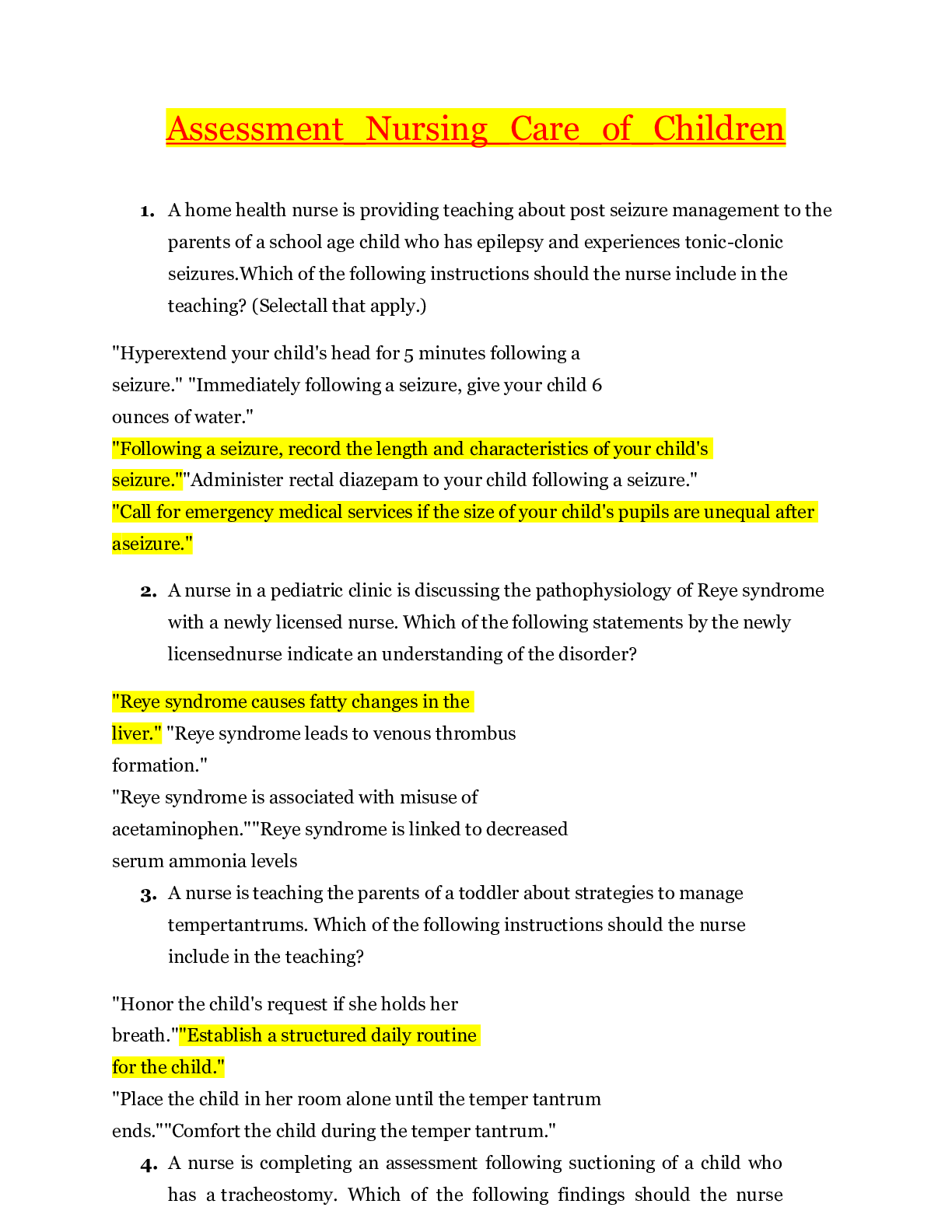
Reviews( 0 )
Document information
Connected school, study & course
About the document
Uploaded On
Jul 17, 2022
Number of pages
36
Written in
Additional information
This document has been written for:
Uploaded
Jul 17, 2022
Downloads
0
Views
39

















